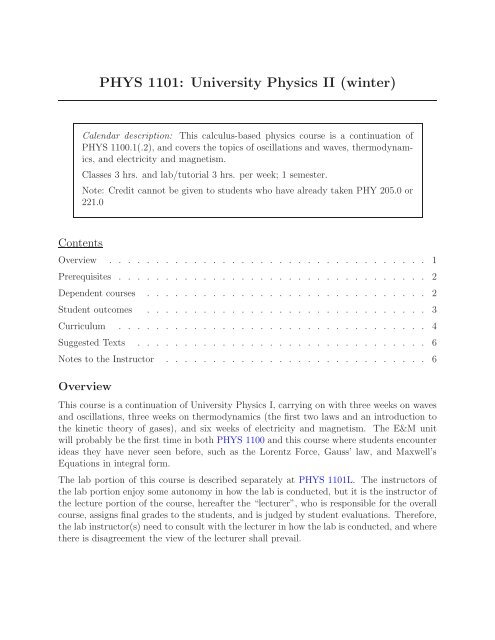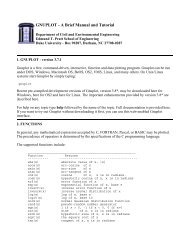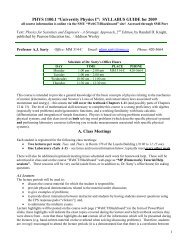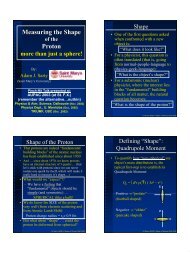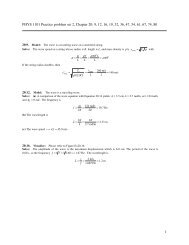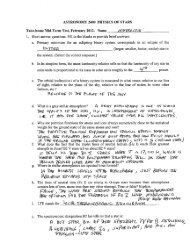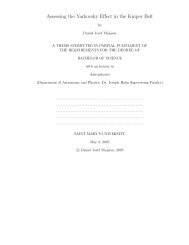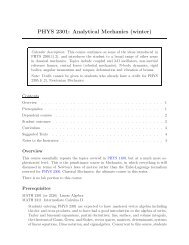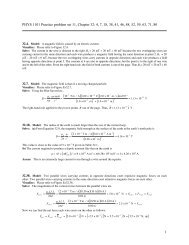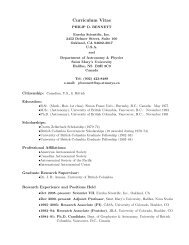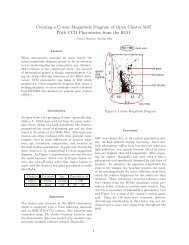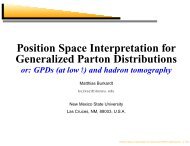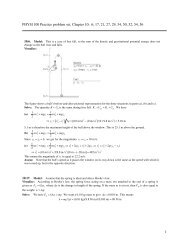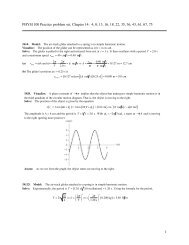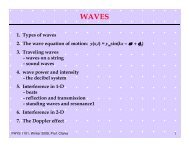PHYS 1101: University Physics II (winter)
PHYS 1101: University Physics II (winter)
PHYS 1101: University Physics II (winter)
You also want an ePaper? Increase the reach of your titles
YUMPU automatically turns print PDFs into web optimized ePapers that Google loves.
<strong>PHYS</strong> <strong>1101</strong>: <strong>University</strong> <strong>Physics</strong> <strong>II</strong> (<strong>winter</strong>)<br />
Calendar description: This calculus-based physics course is a continuation of<br />
<strong>PHYS</strong> 1100.1(.2), and covers the topics of oscillations and waves, thermodynamics,<br />
and electricity and magnetism.<br />
Classes 3 hrs. and lab/tutorial 3 hrs. per week; 1 semester.<br />
Note: Credit cannot be given to students who have already taken PHY 205.0 or<br />
221.0<br />
Contents<br />
Overview . . . . . . . . . . . . . . . . . . . . . . . . . . . . . . . . . . 1<br />
Prerequisites . . . . . . . . . . . . . . . . . . . . . . . . . . . . . . . . . 2<br />
Dependent courses . . . . . . . . . . . . . . . . . . . . . . . . . . . . . . 2<br />
Student outcomes . . . . . . . . . . . . . . . . . . . . . . . . . . . . . . 3<br />
Curriculum . . . . . . . . . . . . . . . . . . . . . . . . . . . . . . . . . 4<br />
Suggested Texts . . . . . . . . . . . . . . . . . . . . . . . . . . . . . . . 6<br />
Notes to the Instructor . . . . . . . . . . . . . . . . . . . . . . . . . . . . 6<br />
Overview<br />
This course is a continuation of <strong>University</strong> <strong>Physics</strong> I, carrying on with three weeks on waves<br />
and oscillations, three weeks on thermodynamics (the first two laws and an introduction to<br />
the kinetic theory of gases), and six weeks of electricity and magnetism. The E&M unit<br />
will probably be the first time in both <strong>PHYS</strong> 1100 and this course where students encounter<br />
ideas they have never seen before, such as the Lorentz Force, Gauss’ law, and Maxwell’s<br />
Equations in integral form.<br />
The lab portion of this course is described separately at <strong>PHYS</strong> <strong>1101</strong>L. The instructors of<br />
the lab portion enjoy some autonomy in how the lab is conducted, but it is the instructor of<br />
the lecture portion of the course, hereafter the “lecturer”, who is responsible for the overall<br />
course, assigns final grades to the students, and is judged by student evaluations. Therefore,<br />
the lab instructor(s) need to consult with the lecturer in how the lab is conducted, and where<br />
there is disagreement the view of the lecturer shall prevail.
2 <strong>Physics</strong> <strong>1101</strong><br />
Prerequisites<br />
<strong>PHYS</strong> 1100 <strong>University</strong> <strong>Physics</strong> I<br />
<strong>PHYS</strong> <strong>1101</strong> depends on this course weakly, as the topics in <strong>1101</strong> (oscillations, waves,<br />
thermodynamics, and E&M) can all, in principle, be taught independently of a course<br />
in mechanics. However, the terms and nomenclature, problem solving skills, and level of<br />
sophistication students gain from <strong>PHYS</strong> 1100 are what make it possible for the instructor<br />
to cover all the material of this course in one term.<br />
MATH 1210 Introductory Calculus I<br />
Students completing MATH 1210 can do any kind of differentiation this course requires.<br />
Students should also be taking MATH 1211 at the same time as this course, and by week<br />
4 when the unit on thermodynamics is begun, students have had a good introduction to<br />
integration. However, the E&M unit starting in week 7 requires the use of closed and<br />
open path and surface integrals which are not covered in MATH 1211, and the instructor<br />
should be prepared to explain these kinds of integrals in class (see Note 2 in the section<br />
Notes to the Instructor).<br />
Students who failed MATH 1210 in the first semester or who took MATH 1090 instead of<br />
MATH 1210 because they failed the placement exam, are now just taking MATH 1210 and<br />
integration will be completely foreign to them. Those students who seek help because of this<br />
have a good chance to get through this course; those who don’t invariably drop it.<br />
Dependent courses<br />
ASTR 2100 Foundations of Astrophysics<br />
ASTR 2100 requires the general physics background and problem-solving skills that<br />
<strong>PHYS</strong> 1100 and <strong>PHYS</strong> <strong>1101</strong> provide.<br />
<strong>PHYS</strong> 2300 Vibrations, Waves, and Optics<br />
<strong>PHYS</strong> 2300 builds directly on the unit on oscillations and waves covered in the first three<br />
weeks of <strong>PHYS</strong> <strong>1101</strong>. In addition, <strong>PHYS</strong> 2300 benefits from the general background in<br />
physics and the problem-solving skills provided by both <strong>PHYS</strong> 1100 and <strong>PHYS</strong> <strong>1101</strong>.<br />
<strong>PHYS</strong> 2400 Electricity and Magnetism<br />
<strong>PHYS</strong> 2500 provides the student with a full-course overview of the E&M unit covered<br />
in this course in its last six weeks. While the ideas introduced in <strong>PHYS</strong> 2500 are largely<br />
the same as those seen here, the level of sophistication of the problems is significantly<br />
higher. To be suitably prepared for <strong>PHYS</strong> 2500, this course should expose students to all<br />
Maxwell’s equations in integral form, including a discussion of the displacement current
<strong>University</strong> <strong>Physics</strong> <strong>II</strong> 3<br />
and the magnetisation of matter.<br />
<strong>PHYS</strong> 3350 Thermal <strong>Physics</strong> (indirectly)<br />
Since <strong>PHYS</strong> 3350 is cycled with <strong>PHYS</strong> 3400 (Electrodynamics), it is possible students<br />
won’t take <strong>PHYS</strong> 3400 until the last semester of their fourth year. Yet, <strong>PHYS</strong> 3400 is<br />
the first time they see thermodynamics formally since the three-week unit given in this<br />
course. Thus, a solid foundation in the first and second laws are critical, as are the ideas<br />
of phase-space (P-V, T-S) diagrams, state variables, and the kinetic theory of gases. All<br />
of these ideas will be revisited and developed further in the first half of <strong>PHYS</strong> 3400, with<br />
the second half devoted to Statistical Mechanics.<br />
Student Outcomes<br />
The development of sound, systematic problem-solving skills is paramount, and will serve<br />
both our students and freshmen engineers (the vast majority of the class) well in any future<br />
physics classes they take.<br />
Students completing <strong>PHYS</strong> <strong>1101</strong> should begin to develop the following skills:<br />
1. gain a competency in units and unit conversions<br />
2. accept different notation conventions<br />
3. develop a systematic and consistent approach to problem solving (e.g., p-V diagrams,<br />
Gaussian surfaces), and learn to translate word problems into mathematical equations.<br />
Many students will cling to their “rules of thumb” and simplistic approaches learned in<br />
high school that don’t work for the more complex problems encountered in this course,<br />
particularly in the E&M unit.<br />
4. be able to visualise a problem and use diagrams effectively<br />
5. apply differential calculus to physics problems<br />
6. learn to conceptualise physics and recalibrate their intuition<br />
Typical problems students completing <strong>PHYS</strong> <strong>1101</strong> should be able to solve:<br />
1. From the sinusoidal representation of a wave or oscillation, determine the period, frequency,<br />
wavelength, amplitude, velocity, etc.<br />
2. Find the amount of useful work that can be extracted from a gas in a system executing<br />
a clockwise rectangular loop on a T-S diagram.<br />
3. What is the capacitance of an isolated charged sphere<br />
4. What is the force on a dielectric slab that is only partially between two charged plates<br />
5. How is a “mag-lev train” propelled
4 <strong>Physics</strong> <strong>1101</strong><br />
Curriculum<br />
In parentheses is an approximate number of lectures to spend on each topic.<br />
In square brackets are the names of various demonstrations as they are listed in the department’s<br />
demonstration catalogue that could be used for each major topic.<br />
1. Oscillations and waves (6) [Oscillator sampler; Wave machine; Slinky; Beating; Doppler<br />
ball]<br />
- SHM, pendulum<br />
- transverse and longitudinal waves<br />
- describing a wave as a sine function<br />
- sound waves<br />
2. Temperature and Heat (2)<br />
- thermal expansion<br />
- heat absorption and conduction<br />
- First Law of Thermodynamics<br />
3. Kinetic Theory of gases (2)<br />
- ideal gas law<br />
- pressure, mean free path<br />
- degrees of freedom, specific heats (C V , C p )<br />
- p-V diagrams<br />
4. Entropy (2) [Entropy be-damned!—the biggest wow of the year]<br />
- state variables, and entropy<br />
- Second Law of Thermodynamics<br />
- p-T, T-S, S-V diagrams<br />
- Carnot cycles (engines and refrigerators)<br />
- state variables along isobars, isotherms, isochors, and isentrops<br />
5. Electric fields (1) [Pith ball; Wimshurst machine (someone will stick their tongue in it<br />
for the class); Tesla coil with discharge tubes (no tongues here!)]<br />
- Coulomb’s law<br />
- the concept of a field<br />
- fields due to line and disc charges<br />
6. Gauss’ law (2)
<strong>University</strong> <strong>Physics</strong> <strong>II</strong> 5<br />
- electric flux through closed and open surfaces (integrals)<br />
- point, line, and sheet charges<br />
7. Potential (2)<br />
- electric potential of point, line, and sheet charges<br />
- dipole, charged isolated conductor<br />
- dielectrics and capacitance<br />
8. Circuits (1) [Circuits in parallel and series]<br />
- current, resistance, and resistivity<br />
- Ohm’s Law<br />
- Kirchhoff’s Rules as a restatement of conservation of energy and charge<br />
- resistors in parallel and series<br />
- simple circuits (and ”monster” circuits; e.g., question 6, p 653, HRW Ed. 6)<br />
9. Magnetic fields (3) [Lorentz force: CRT; Lorentz force: Current; Induced ⃗ B in a<br />
solenoid]<br />
- Lorentz forces (another example of the cross product)<br />
- Hall effect<br />
- Biot and Savart (an apparent “violation” of Newton’s 3rd Law)<br />
- magnetic force on a current-carrying wire<br />
- magnetic dipole<br />
- Ampere’s law<br />
- solenoids and toroids<br />
10. Induction (2) [Induction: Solenoid; Induction: Eddy currents]<br />
- Lenz’ and Faraday’s law<br />
- induced and non-conservative electric fields, eddy currents<br />
11. Maxwell’s equations (1)<br />
- no magnetic charges<br />
- induced magnetic fields<br />
- displacement current<br />
- summary of Gauss’ Laws, Faraday’s Law, and Ampere-Maxwell Law, all in integral<br />
form
6 <strong>Physics</strong> <strong>1101</strong><br />
Suggested texts<br />
The text used for this course should be the same as the text used for <strong>PHYS</strong> 1100.<br />
Notes to the instructor<br />
1. <strong>PHYS</strong> 1100 and <strong>PHYS</strong> <strong>1101</strong> serve two primary purposes:<br />
- foundation courses for (astro)physics majors;<br />
- service courses for chemistry and the engineering programme.<br />
These two purposes are often at loggerheads—the level needed by our potential majors<br />
is often higher than that needed by the engineers.<br />
Historically, these courses have been taught at a level neither higher nor lower than<br />
necessary to provide a thorough treatment of Halliday, Resnick and Walker, where any<br />
and all problems in that text are fair game for assignments and, to a lesser extent,<br />
exams. In practise, this has meant teaching to the B/B+ students.<br />
2. Integration seen in MATH 1211 is strictly 1-D. The integration in the thermodynamics<br />
unit is really path integration but is well-disguised as ordinary 1-D integrals (and<br />
students need not be the wiser). On the other hand, the integrals in the E&M unit<br />
are bona fide open and closed surface and path integrals, and it is difficult to disguise<br />
them as anything else. The instructor should be prepared to spend the equivalent of<br />
half a lecture in aggregate over the course of two or three classes explaining what these<br />
kinds of integrals actually mean, and how they differ from ordinary 1-D integrals.<br />
3. Demonstrations in this class are even more important than in the preceding course<br />
<strong>PHYS</strong> 1100, particularly in the E&M unit where students are exposed to what may be<br />
the first new ideas to them since the beginning of <strong>PHYS</strong> 1100. Some of the phenomena<br />
in E&M are quite unbelievable until seen (e.g., the Lorentz force, Eddy currents, the<br />
generation of current in a solenoid by inserting a permanent magnet), and students<br />
will have almost no intuition upon which to rely.<br />
4. Instructors for the three first-year courses [<strong>PHYS</strong> 1100 (<strong>University</strong> <strong>Physics</strong> I), this, and<br />
<strong>PHYS</strong> 1500 (Introduction to Modern <strong>Physics</strong>)] are strongly urged to discuss and agree<br />
upon a mutually suitable text in time for ordering texts for the fall.<br />
5. The portion of course grade assigned to the laboratory portion (<strong>PHYS</strong> <strong>1101</strong>L) should<br />
be between 20% and 30%.<br />
6. It has been this department’s policy that students repeating this course may be exempt<br />
from repeating the laboratory portion if :<br />
- the grade attained in the lab portion in the previous attempt of the course was a<br />
C− or better;
<strong>University</strong> <strong>Physics</strong> <strong>II</strong> 7<br />
- the grade attained in the lab from the previous attempt of the course is used as<br />
the lab grade for the current attempt<br />
Students exempted from repeating the lab portion should not, however, be exempted<br />
from repeating the tutorial portion of the course, should tutorials be part of the course.


